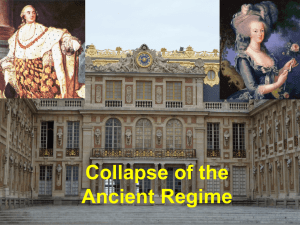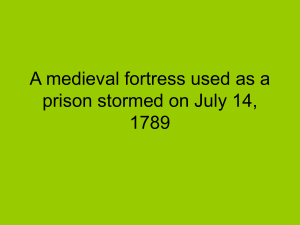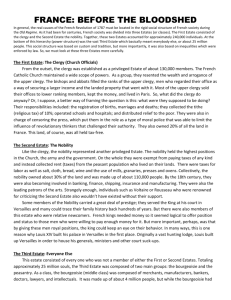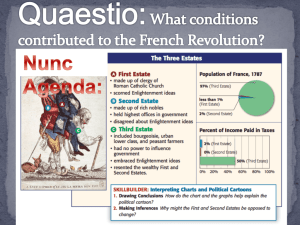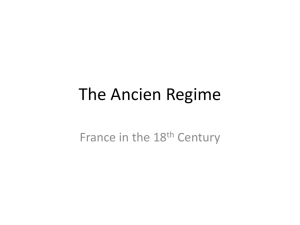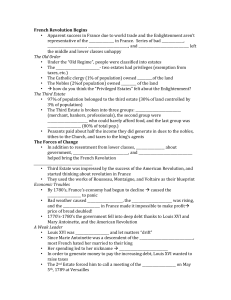Causes of the French Revolution
advertisement
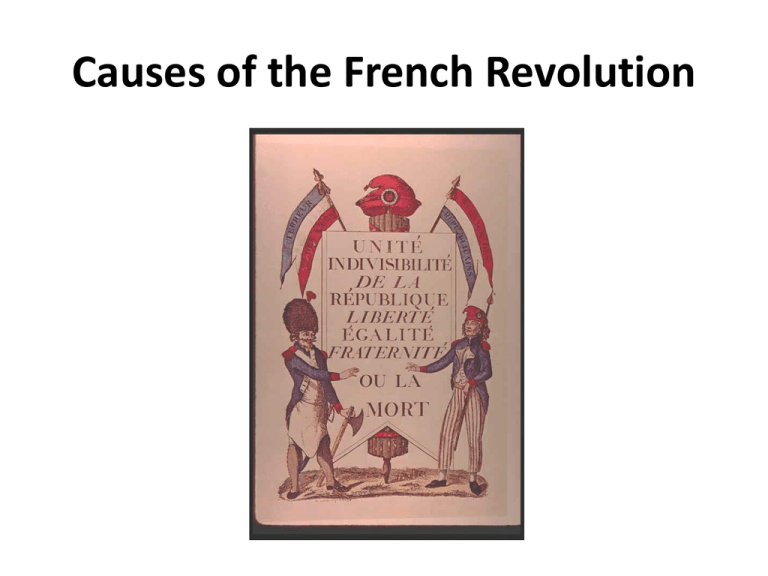
Causes of the French Revolution Voltaire Cultural Causes Montesquieu Cultural Causes • Influence of the Enlightenment: -18th century philosophes like Rousseau, Voltaire, Montesquieu, & Diderot -Drew attention to the political & social problems -Urban centers-educated middle class began to criticize the social class system known as the Estates Cultural Causes: The Enlightenment Period of time when world’s greatest thinkers/“philosophers” were sharing ideas and changing the way ordinary people viewed world. Examples: CHURCH • Should church be rich? •Must do everything priest says? NOBILITY -Share power/privilege! -Abuse of position GOVERNMENT •Should kings have complete control? •Are kings directly associated with God? Example of a quote by one of these famous enlightened philosophers, Voltaire: “The art of government consists of taking as much money as possible from one class of citizens to give to another.” As these new thoughts and teachings spread, the poor peasant class realize that perhaps it’s time for a change... Cultural Causes • Warned of the dangers of tyranny & religious intolerance • Questioned the relationship between the people & their king • Thought all men had certain rights like freedom of speech, press, & right to fair trial Baron de Montesquieu • Critical of absolute monarchy • Member of French nobility who supported a constitutional monarchy • Did not support a constitutional republic • Wanted a government headed by a king who had the right to veto acts of the legislature • Wanted separation of power between three branches of government • His ideas appealed to the Second Estate who argued at the Meeting of the Estates-General that the traditional rights and privileges of the nobility should be protected from an abusive absolute monarch Voltaire • Spent much of this career fighting for religious toleration and a system of justice where all citizens are treated equally under the law • Critical of the unfair Estates System---”You do not hear in England of one kind of justice for the higher class, a second for the middle, and a third for the lowest.” • Saw his pen as a weapon in the fight for justice • “I have no sceptre, but I have a pen.” Rousseau • Popularized the ideas of the Social Contract in France • He wrote much of the evils of civilization and not its benefits. • He spelled out the institutions necessary to correct the injustices brought about by civilization. • Spoke of virtue in a republic • This virtue requires citizen patriotism and reasoned devotion to the national community. • Profound influence on Robespierre---”The soul of the republic is virtue, love of country, the generous devotion that fuses all interests into the general will.” Cultural Causes: Political Pamphlet by Rousseau “The people should have power, 1775. Man is born free. No man has any natural authority over others; force does not give anyone that right. The power to make laws belongs to the people and only to the people.” (a pamphlet, banned by the French government in 1775, Jean Jacques Rousseau.) Cultural: Emmanuel Joseph Sieyes • A reform-minded clergymen who was elected as a representative of the Third Estate to the Meeting of the Estates-General • Wrote the famous pamphlet called “What is the Third Estate?” • As a commoner, Sieyes could not rise to a bishop position. • His frustrations may have contributed to his violent animosity towards the aristocracy. • His pamphlet made him an oracle of the French Revolution. • In his eyes, the Third Estate was the nation, and he, more than any other, led the Third Estate in the early weeks of the Estates-General. Cultural Causes: What is the Third Estate? Cultural Causes • Political pamphlets circulated in the cafes & homes of the bourgeoisie. • Gathered in salons to discuss the new ideas & the recent American Revolution. Cultural Causes • During Louis XVI's reign, the press was censored. • No criticism of the King's policies was allowed. • At the onset of the French Revolution, the press was given complete freedom, and introduced harsh critiques of the government. • Refer to the Political Causes Section: AntiMarie Antoinette Propaganda Cultural Causes: American Revolution • Served as a model of rebellion against a monarchy • Used Declaration of Independence and Constitution as models • Thomas Jefferson, Benjamin Franklin, and Thomas Paine corresponded with the leaders of the French Revolution and/or visited France to advise them •The Phrygian cap also appears in ancient Rome as the cap of the freedman (liberty cap) and is associated with the winter holiday Saturnalia. • Much later, French Revolutionaries adopted the Phrygian cap to stand for freedom. Social Causes The Estates System THE FRENCH CITIZENS Estates General 1ST (1%)Catholic Clergy (2%)Nobility 2ND (97%)Everyone Else 3RD Social Causes: The Three Estates Varied widely in what they contributed in terms of work and taxes First Estate Second Estate • Roman Catholic clergy • Nobility • One percent of the population • Less than 2 percent of the population • Exempt from taxes • Paid few taxes • Owned 10 percent of the land – Collected rents and fees – Bishops and other clergy grew wealthy • Controlled much wealth • Held key positions – Government – Military • Lived on country estates Third Estate • Largest group—97% of the population • Bourgeoisie—citydwelling merchants, factory owners, and professionals • Sans culottes— artisans and workers • Peasants—poor with little hope, paid rents and fees Three Estates 100% 90% 80% 70% 60% 50% 40% 30% 20% 10% 0% Clergy Nobility Commoners Land Ownership Taxation Population King Louis XVI (16th) Estates Determine rights, obligations, status. Difficult to move up (Absolute Monarch - Right to rule by God) The 3 Estates First Estate Third Estate Second Estate •Bourgeoisie CLERGY NOBILITY (0.004%) (0.02 %) •Sans Culottes •Owned land •PEASANTS •Very wealthy. •Paid no taxes. •Owned land (98%) •Very wealthy •Few owned land •Paid no taxes •Paid a LOT of taxes. (1/2 $) •Most extremely poor. •Charged “tithes” Add the numbers. •Not allowed to hunt 1 Extremely wealthy king with great power 1 Group of rich clergy members + 1 Group of rich nobles, doing as they wish 1 Huge group of poor, frustrated, starving peasants/workers 1 REVOLUTION WAITING TO HAPPEN :-( Social Causes: Estates System • First Estate: – 100,000 to 130, 000 members of the clergy; 10,000 were upper clergy; 1% of the population – Huge wealth & great influence over local & national government = 80 to 120 million livres – Highest clergymen like cardinal, bishops, archbishops, & abbots came from the nobility; could be paid up to 400,000 livres a year – Lower clergy like parish priests & monks came from the lower classes; were poor, uneducated, and lived like the peasants---60,000 parish priests & 60,000 monks and nuns – Owned 10% of the land in France; collected taxes & produce from the land Social Causes: First Estate • Consisted of members of the clergy---priests, bishops, monks, and nuns • The upper clergy of bishops and cardinals came from rich noble families and behaved in the corrupt manner of the Medieval and Renaissance clergy. Social Causes: First Estate -Clergy did not pay taxes -Church controlled schools, hospitals, and press -Had separate courts system -Supported divine right -Provided social services to the poor -Clergy divided; upper clergy arrogant, acted like nobles, & looked down on the parish priests -Parish priests wanted to reform the church & society; identified with the Third Estate Social Causes: Second Estate • Made up of the nobility: dukes, counts, & marquises • Many lived on huge estates; lived off the income from their lands • Held the highest jobs in army, navy, church, court, king’s ministers, & diplomats • 400, 000 members; 50,000 noble families; 2 to 5% of the population • Owned 20% of the land in France Social Causes: Second Estate • Consisted of the nobles/aristocracy • Owned most of the land in France • Were the courtiers who lived at Versailles and did not work • On their own lands, they have powers similar to a king • Most French peasants were virtually slaves to the lords who owned the land on which they worked and taxed them on everything Social Causes: Second Estate • Politically conservative & determined to oppose any reforms that would take away their privileges. • Some nobles born into position-known as Nobles of the Sword; others bought their title from the Kingknown as Nobles of the Robe • There was a hierarchy among the nobles-? Noble blood • Exempt from taxes (Taille) • Exclusive hunting rights • Own courts system Social Causes: Second Estate • The court nobles lived a life of debauchery-partying, gambling, affairs, low morals,…part of Marie Antoinette’s crew---rumors and scandals developed • Nobles of the Robe held posts in Parlement and courts; outranked the court nobles; but arranged marriages of daughters to sons of court nobles to gain closer relationship to King & Queen • Collected rents, corvees, & taxes from peasants • Liberal nobles favored the philosophes & called for reform & a constitutional monarchy like Marquis de Lafayette & Comte de Mirabeau Second Estate: The Seigneurial System • Feudal method of land ownership and organization • Peasant labor Receiving a seigneurial grant Second Estate: NOBILITY •Rich from parents/land rent/no taxes to pay •Desire to return to feudal system •Wanted more power from King •Resisted wealthy merchants from joining •Extravagant spending: Example: Hairstyles so high, afraid to dance in fear of hair catching fire from chandeliers! Second Estate Second Estate-Nobility • Lords could: – Ride across peasants’ fields when hunting, even if there were crops growing – Keep rabbits, which the peasants weren’t allowed to kill even if they were eating their crops – Keep pigeons, which the peasants weren’t allowed to kill even if they were eating their crips Social Causes: Third Estate • Rest of population; about 25 million • 2.3 million or 8% of the population made up the Bourgeoisie---middle class; landowners, lawyers, doctors, merchants, craftsman, writers, etc… • Bourgeoisie owned about 20% of land • Lived in the cities; copied the dress of the nobility; upwardly mobile • Frustrated by their lack of power & privilege • Wanted all Church, army, & govt positions to be opened up to men of talent & merit • Wanted a constitutional monarchy, fair trials, religious freedom Third Estate: Bourgeoisie or Middle Class • Part of the Third Estate, they were the “middle class” of France. • They were bankers, merchants, factory owners (educated people) • Led the revolution Third Estate: Bourgeoisie • • • • Welcome to the world of the bourgeoisie, a class that walked the line between middle class and aristocracy with image as its balancing pole. The bourgeoisie was a class fighting for freedom from the aristocracy while simultaneously striving to attain the privilege of that class. For the social climbing bourgeoisie, image was everything. Members of the bourgeoisie utilized fashion to mimic the air of the aristocracy, outings to the theater and the opera to inflate their public image, and appearances at restaurants and casinos to demonstrate their economic status and their aristocratic taste. •In addition, members of the bourgeoisie spent many hours promenading through gardens. •But in all places a social climbing bourgeoisie must behave with grace in order to fully mimic the noble image, thus proper etiquette was essential. • This ironic mix of revolutionary spirit and high society aspirations forms the essence of the bourgeoisie. Bourgeoisie Bourgeoisie Social Causes: Third Estate and Peasants • Peasantry-about 21 million people • Collectively owned 30 to 40% of the land • Most rented land from other peasants or nobles • Tried to supplement income by working as day laborers or textile workers • Victimized by the heavy taxes to King, Nobles, and Church Social Causes: Third EstatePeasants • Every year the peasants had to give part of their crops to the King, to the nobles, and to the Church, so there was little left for them to sell and eat • They had to build or repair roads and bridges for no pay Peasants Social Causes: Third Estate and SansCulottes • Sans-culottes: urban workers or artisans, factory workers, dock workers, etc… • Lived in poverty • Most politicized group of poor people due to high literacy rate Sans-Culottes • The sans-culottes were the common people of Paris, and were so named this because they didn't wear upper class breeches or culottes. • They were the working people, the shop owners, the trades-people, the artisans, and even the factory workers. • They were among the prominent losers of the first, more subtle revolution. • While the middle class and wealthy classes benefitted greatly from the revolution, the sans-culottes saw their livelihoods disappearing and inflation driving them to fight for survival. • Of all the groups of France, the views of the sans-culottes is what drove the radical revolution from 1792 to 1794---Robespierre, National Convention, Republic, and Reign of Terror. • Sans-Culottes The desires of the sans-culottes were simple. They believed that survival was a right of all people, inequality of any kind was to be abolished, and the aristocracy and the monarchy were to be eliminated. • Property was not to be completely eliminated, but to be shared in communal groups. • These ideas were far more radical than what the Jacobins had in mind. However, more radical Jacobins sympathized with the sansculotte and began to work with them. • This radical group of Jacobins were called the Mountain, because they took the highest seats in the Assembly. Sans-Culottes Sans-Culottes Pamphlet • Pamphlet trying to describe who the sans-culottes were • “A sans-culotte, you devils? This is a creature who always goes on foot, who does not own millions of livres, as you would all like to do, owns no chateau, has no servants to do his bidding, and who lives very simply, with his wife and children, if he has any, on the fourth or fifth floor. • He is useful, for he knows how to work in the fields, or in a smithy or sawmill, how to use a file, how to cover a roof, make his own clogs - and how to pour out his blood to the last drop for the good of the republic. And since he is at work, one may be sure not to see his face in the fashionable Chartres café nor in the low bars where there is conspiring and gambling, nor in the literary salons” Sans-Culottes Pamphlet Continued • “In the evening he goes to his section meeting, without powder or scent or boots, not with any hope of being noticed by the women citizens on the benches, but in order to lend all his strength to sound motions, and to crush any which arise from the odious faction of so-called statesmen. Apart from that, sans-culotte always has an edge on his blade: to trim the ears of ill-wisheirs. Sometimes he marches with his pike; but at the first sound of the drum you may see him setting off for the Vendée, for the army of the Alps or of the North. “ "Liberty, Equality, Fraternity" SLOGAN OF THE FRENCH REVOLUTION MEANT DIFFERENT THINGS TO DIFFERENT CLASSES OF PEOPLE Members clergy less than 1 % Needs A decrease in the power of the Monarch and increase in their political power. Maintain their property rights Nobility less than 2 % To maintain their current position 3rd estate 97 % upper drs., merchants Political Power to match their economic power which meant the elimination of the Monarch 1st estate 2nd estate middle artisans less taxes and lower rent



